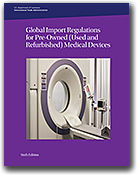|
|
|
||||||||
|
Short Takes: News from the International Trade Administration Getting the Details on the World Market for Used Medical Devices Getting the details on the world market for used and refurbished medical devices just became much simpler with the International Trade Administration’s updated edition of Global Import Regulations for Pre-Owned (Used and Refurbished) Medical Devices. World markets for used medical equipment are important, but some of the most basic facts about those markets—such as size, location, and national laws and regulations that affect such trade—are either non-existent or difficult to come by. The publication offers U.S. exporters of used medical equipment a comprehensive listing of the regulations that govern this important and growing trade. The 170-page report includes detailed country-by-country entries for 106 markets. Each country entry includes an in-depth discussion of the regulatory environment for imports of used medical equipment. Also noted are related topics that may affect trade, such as sanitary codes, customs valuations, and taxes. Most entries include lists of government and trade association contacts. The information in the publication is based on reports from the International Trade Administration’s worldwide network of in-country commercial analysts. Global Import Regulations for Pre-Owned (Used and Refurbished) Medical Devices can be downloaded from the International Trade Administration’s publications Web page.
Online Ticker Marks $1 Billion in Tariffs Paid on U.S. Exports to Colombia On May 4, 2008, the Colombia Tariff Ticker, which is an online ticker that counts the amount of tariffs paid on U.S. exports to Colombia, passed the $1 billion mark. The ticker, which can be viewed on the International Trade Administration’s homepage, tracks the estimated tariffs imposed on U.S. exports entering Colombia since the U.S.–Colombia Trade Promotion Agreement (TPA) was signed on November 22, 2006. The agreement is awaiting approval by Congress. In a statement released the next day, Secretary of Commerce Carlos M. Gutierrez issued a strong statement in favor of passing the TPA with Colombia. “American-made exports, up nearly 13 percent last year, are providing a critical spark to our economy at a time when American families are facing economic challenges. Congress needs to pass the U.S.–Colombia TPA so we can lift the billion-dollar burden on our exports and institutionalize permanent, fair, and two-way free trade with Colombia.” More than 90 percent of Colombian products enter the United States duty free because of the Andean Trade Preference Act signed in 1991. Under the proposed agreement, many U.S. products will enjoy similar tariff-free access into Colombia. Colombia is the second-largest market for U.S. agriculture in the Western Hemisphere after the North American Free Trade Agreement market. The U.S.–Colombia TPA will benefit U.S. small and medium-sized businesses (SMEs) the most. More than 10,000 U.S. companies export to Colombia, of which 8,500 are SMEs. The tariffs paid by U.S. exporters to Colombia displayed on the ticker are an estimate based on data from the World Trade Atlas and Colombian tariff schedules. The ticker number includes the best estimate of the variable effect of Colombia’s agricultural price bands. More information on the U.S.–Colombia TPA is available on the International Trade Administration’s Web site.
New Edition of Guide to Export Financing Available The International Trade Administration’s Manufacturing and Services unit recently published a revised edition of Trade Finance Guide: A Quick Reference for U.S. Exporters. Originally published in early 2007, this second edition is a concise and easy-to-understand resource created specifically for small and medium-sized enterprises (SMEs) that are unfamiliar with the details of export financing. “Since its publication last year, the Trade Finance Guide has been an effective, useful finance resource for America’s small and medium-sized enterprises,” said William G. Sutton, assistant secretary of commerce for manufacturing and services. “This tool helps SMEs turn export opportunities into actual sales and makes it easier for them to do business internationally.” The revised edition includes a new chapter on foreign exchange risk management, as well as minor updates to other sections. The additional content was added because of requests from several SMEs that wanted to export more efficiently in foreign currencies by mitigating the risk of currency exchange loss. The Trade Finance Guide was created by the International Trade Administration through a public–private partnership with the FCIB, an Association of Executives in Finance, Credit, and International Business; the U.S. Small Business Administration; the Export–Import Bank of the United States; the International Factoring Association; and the Association of Trade and Forfaiting in the Americas. The Trade Finance Guide: A Quick Reference for U.S. Exporters is available online at www.trade.gov. Printed copies can be obtained from the Trade Information Center at 1-800-USA-TRAD(E) (1-800-872-8729) and from the U.S. and Foreign Commercial Service’s network of domestic Export Assistance Centers and overseas posts. A list of those centers is available online at www.export.gov. |
|
